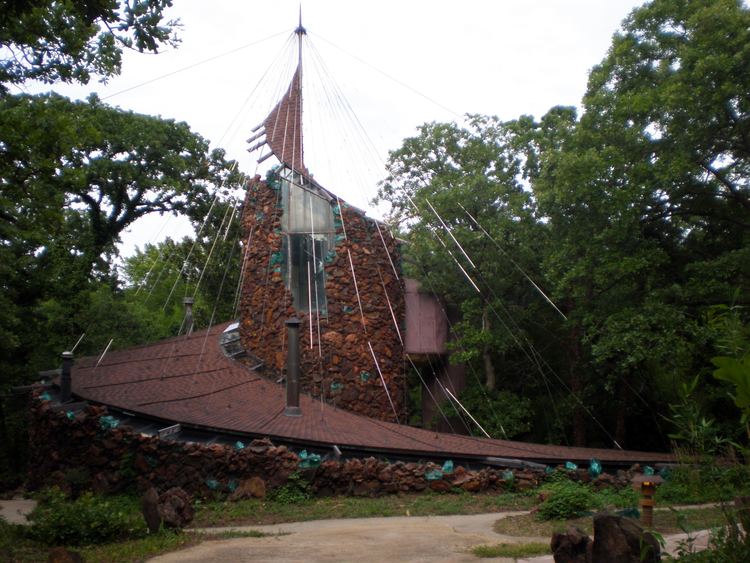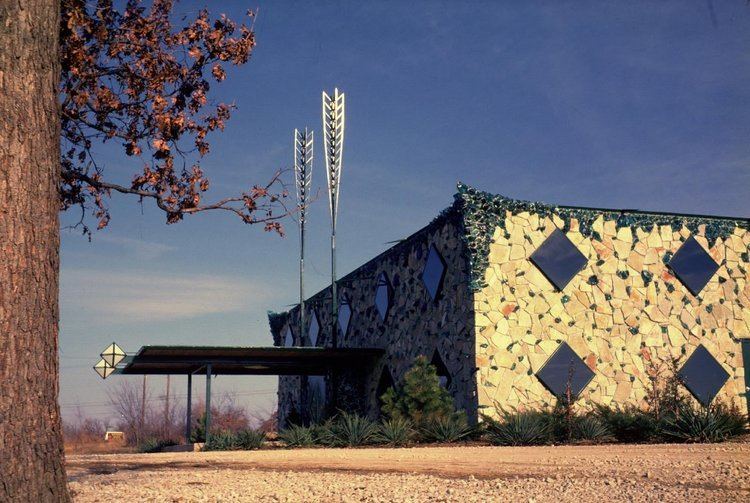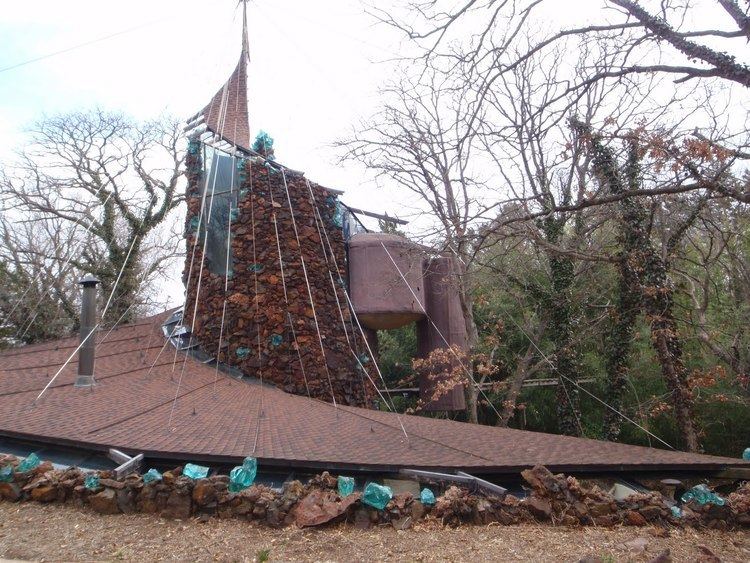Nationality American Role Architect | Name Bruce Goff Occupation Architect | |
 | ||
Full Name Bruce Alonzo Goff Buildings Bavinger HouseRuth VanSickle Ford HouseLedbetter HousePavilion for Japanese Art Books Bavinger House, Norman, Oklahoma, 1950: Price House, Bartlesville, Oklahoma, 1957-1966 Structures Eugene Bavinger House, Pavilion for Japanese Art, Boston Avenue Methodist, Ledbetter House, John Frank House | ||
Discover oklahoma bruce goff
Bruce Alonzo Goff (June 8, 1904 – August 4, 1982) was an American architect, distinguished by his organic, eclectic, and often flamboyant designs for houses and other buildings in Oklahoma and elsewhere.
Contents
- Discover oklahoma bruce goff
- Bruce goff playtower at sooner park
- Early years
- Teaching
- Work
- Selected works
- Contributions
- Death
- References

A 1951 Life Magazine article stated that Goff was "one of the few US architects whom Frank Lloyd Wright considers creative...scorns houses that are ‘boxes with little holes."

Bruce goff playtower at sooner park
Early years

Born in Alton, Kansas, Goff was a child prodigy whose family moved to Tulsa, Oklahoma in 1915. He was largely self-educated and displayed a great talent for drawing. His father apprenticed him at age twelve to the Tulsa architectural firm of Rush, Endacott and Rush. Goff's employers were impressed with his talent; they soon gave him responsibility for designing houses and small commercial projects. One of his earliest designs that was actually built was a house at 1732 South Yorktown Avenue in Tulsa's Yorktown Historical District; another was the 1920 McGregor House, at 1401 South Quaker Street in what is now known as the Cherry Street District. This house was added to the National Register of Historic Places in 2014. During this period, his work was heavily influenced through his correspondence with Wright and with Louis Sullivan, both of whom had encouraged him to practice architecture with Rush, Endacott and Rush instead of enrolling in Massachusetts Institute of Technology; they felt the formal education would stifle his creativity. Goff was made a firm partner in 1930. He and his high-school art teacher Adah Robinson are co-credited with the design of Tulsa's Boston Avenue Methodist Church, one of the finest examples of Art Deco architecture in the United States.
Teaching

In 1934 Goff moved to Chicago and began teaching part-time at the Academy of Fine Arts. He designed several Chicago-area residences and went to work for the manufacturer of "Vitrolite", an architectural sheet glass introduced during the 1930s. At the outbreak of World War II, Goff enlisted in the U.S. Navy, was assigned to the Naval Construction Branch ("Seabees"), and designed a number of military structures and residences during his service. He also obtained a teaching position with the School of Architecture at the University of Oklahoma in 1942. Despite being largely self-taught, Goff was named chairman of the school in 1943. This was his most productive period. In his private practice, Goff built a large number of residences in the American Midwest, developing his singular style of organic architecture that was client- and site-specific.

In 1955, Goff, who was homosexual, was accused of "endangering the morals of a minor", as homosexuality was not socially acceptable in Oklahoma in 1955. As a result of the unproven claims, he was forced to resign from his position at the University of Oklahoma. Historians and writers have expressed their belief that Goff was politically forced from his position specifically for being homosexual.
In 1955, Goff relocated his studio to the Price Tower in Bartlesville, Oklahoma, which had been designed by his mentor Frank Lloyd Wright. There he continued to produce novel designs, and also spent considerable time traveling and lecturing. Articles about his ideas and designs appeared frequently in professional magazines, such as Progressive Architecture, Art in America and Architectural Forum. In 1960–1961 he had Arthur Dyson as an apprentice in his office.
Work
Goff's accumulated design portfolio of 500 projects (about one quarter of them built) demonstrates a restless, sped-up evolution through conventional styles and forms at a young age, through the Prairie Style of his heroes and correspondents Frank Lloyd Wright and Louis Sullivan, then into original design. Finding inspiration in sources as varied as Antoni Gaudi, Balinese music, Claude Debussy, Japanese ukiyo-e prints, and seashells, Goff's mature work had no precedent and he has few heirs other than his former assistant, New Mexico architect Bart Prince, and former student, Herb Greene. His contemporaries primarily followed tight functionalistic floorplans with flat roofs and no ornament. Goff's idiosyncratic floorplans, attention to spatial effect, and use of recycled and/or unconventional materials such as gilded zebrawood, cellophane strips, cake pans, glass cullet, Quonset Hut ribs, ashtrays, and white turkey feathers, challenge conventional distinctions between order and disorder.
A number of Goff's original designs are on display at the Modern Wing at the Art Institute of Chicago.
In 2002 director Heinz Emigholz produced the documentary film Goff in the Desert which depicts 62 of Bruce Goff's buildings. He also used imagery from this movie for the music video Celtic Ghosts of German band Kreidler.
Selected works
Goff was active from the 1920s until his death, with several posthumous projects completed by associates. A number of his works were considered for listing on the U.S. National Register of Historic Places. The following are selected major works:
Contributions
Goff's contributions to the history of 20th-century architecture are widely praised. His extant archive—including architectural drawings, paintings, musical compositions, photographs, project files, and personal and professional papers—is held by the Ryerson & Burnham Libraries at the Art Institute of Chicago.
His Bavinger House was awarded the Twenty-five Year Award from the American Institute of Architects in 1987, and Boston Avenue Methodist Church was designated a National Historic Landmark in 1999.
Death
Goff died in Tyler, Texas, on August 4, 1982. His cremated remains are interred in Graceland Cemetery, Chicago, Illinois, with a marker designed by Grant Gustafson (one of Goff's students) that incorporates a glass cullet fragment salvaged from the ruins of the Joe D. Price House and Studio.
